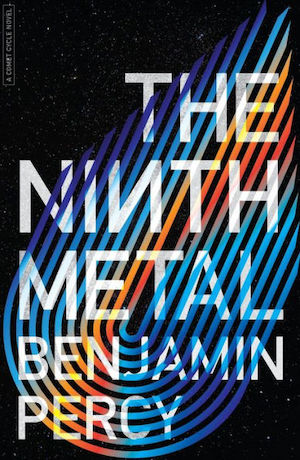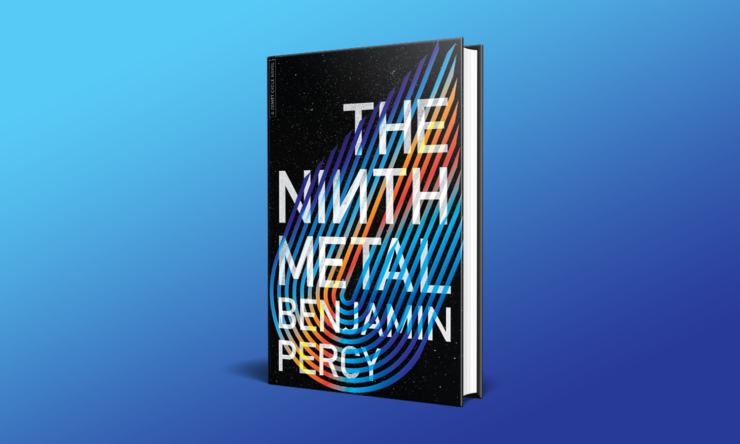Here’s the thing about writers: they write. When I was a young reader venturing into the world of superhero comics, it surprised me when I’d see named I recognized from the DC and Marvel universes showing up on the spines of paperbacks; I’m pretty sure I still have copies of Chris Claremont’s First Flight and Jim Starlin and Daina Graziunas’ Among Madmen around here somewhere. But that shouldn’t have been as much of a shock as it was—the generation of British comics writers that followed (think Alan Moore, think Neil Gaiman) worked across formats from the outset, and that’s been the status quo ever since.
Some of the writers who made an impact on superhero comics in the last decade came from a prose background—Scott Snyder, G. Willow Wilson, and Eve L. Ewing among them. Benjamin Percy also falls pretty neatly into this category, with a body of prose work that includes everything from Red Moon, a sprawling werewolf epic, to the unnerving narratives found in the collection Suicide Woods. Percy has also written a host of superhero books for Marvel and DC, including runs on Green Arrow and Wolverine. But unlike many a writer with a foot in both camps, Percy also seems curious about seeing what he can transplant from one to the other; thus, his new project, dubbed The Comet Cycle, of which his novel The Ninth Metal is the first part.
In a recent essay for Literary Hub, Percy wrote specifically about wanting to create the feeling of a shared universe across a group of novels. “I wanted to upend my reader’s understanding and expectations of the world,” Percy writes. “If I built something that defied easy explanation I might create something that was in short supply in my life and the world: awe and wonder. The sublime.”
What that means for The Ninth Metal, then, is that it faces a twofold challenge: how is it as a standalone novel? And how does it do at evoking the sense of something larger? The answers, in short, are “very good” and “very well”—but there’s a bit more to both of those answers than that.
First and foremost, it’s worth noting Percy is well aware of the sandbox around him, and he throws in more than a few allusions to superhero comics as the narrative of The Ninth Metal progresses. But while Percy is well aware of that genre, it’s not the adventures of Bruce Wayne or Carol Danvers that come to mind here. Instead, Percy seems to be paying homage to a very different fictional narrative over the course of this novel—and it’s an unexpected delight.
Buy the Book


The Ninth Metal
The Ninth Metal begins by focusing on a boy named Hawkin living in northern Minnesota. One night, something terrible happens to both of his parents, and then something transformative happens to the entire world—matter left behind by a comet comes crashing down to the planet’s surface.
From there, the story jumps forward in time by five years. We’re introduced to John Frontier, a man in his mid-twenties in an Army uniform, traveling to his family’s home for his sister’s wedding. Soon enough, we’ll learn that John’s father is a wealthy industrialist with a nebulous moral code; we’ll also meet his siblings, one prone to violence and one effectively distanced from the family. And if you don’t start hearing a certain Nino Rota theme in the back of your mind during these passages, you’re a stronger reader than me; the fact that John’s sister shares a first name with the actress who played one of the Corleone siblings in The Godfather seems like a very particular hat-tip on Percy’s part.
But here’s the thing: if Percy did throw in an extended homage to The Godfather when establishing the family at the heart of the story, it works. It works in part because he doesn’t lean on it too much, and it works in part because, once he’s established some of the basic character dynamics, he then takes things in a very different direction.
Some of this has to do with the substance that gives the book its title, omnimetal. If readers note that it has some resemblances to both Marvel’s Vibranium and DC’s Nth Metal, they won’t be wrong—but the bulk of the novel is less about what it can do and more about power struggles by the wealthy and powerful to control it. Which isn’t to say that it’s merely a McGuffin, either; omnimetal does have a transformative effect on technology and biology. But at its core, this is a story about power, family, betrayal, and greed—something with more in common than the aforementioned Coppola film or J.C. Chandor’s A Most Violent Year than the latest MCU installment.
The Ninth Metal’s crime-fiction bones help keep the more fantastical elements of the narrative grounded. Eventually, we learn what became of young Hawkin in the intervening years; Percy also introduces a subculture of people addicted to the residue of omnimetal. And there’s a cult in town that acts as another type of power broker; here, Percy hints at some of the larger questions of his fictional setting.
Over the course of the novel, Percy makes it clear that the presence of omnimetal isn’t the only way the world has been changed by the effects of the comet. There are hints of something larger happening—monstrous effects on wildlife, strange dreams afflicting some people, odd vegetation popping up around the globe. The sense of something larger happening, of which John and his family are on the fringes, grows steadily over the course of the book; by the end, it’s done a fine job of setting the stage for the larger world Percy is building out.
The Ninth Metal is available from Mariner Books.
 Tobias Carroll is the managing editor of Vol.1 Brooklyn. He is the author of the short story collection Transitory (Civil Coping Mechanisms) and the novel Reel (Rare Bird Books).
Tobias Carroll is the managing editor of Vol.1 Brooklyn. He is the author of the short story collection Transitory (Civil Coping Mechanisms) and the novel Reel (Rare Bird Books).










